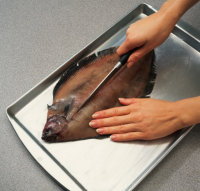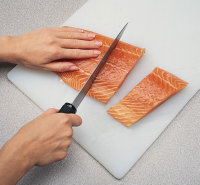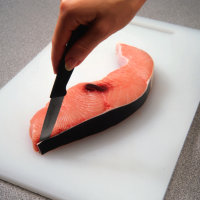How Long To Cook Fresh Fish
The first step in becoming a seafood aficionado is buying the right type of fish for your recipe. The seafood counter at your local supermarket can be a little intimidating, but here is a quick guide for choosing the perfect fish.
Types of Fish
There are literally hundreds of species of fish readily available today. From this vast variety there are bound to be types sure to please any taste.
Fresh fish are generally separated into two categories -- lean and fatty. Lean fish contain 1% to 5% fat. Fatty fish contain 5% to 35% fat,
which makes their flesh darker, richer, and stronger tasting than lean fish.
The type of fish is an important factor when it comes time for preparation and cooking. For
easy reference to types of fish, their availability, and preferred cooking methods, we've created a handy Fish Cooking Chart for your reference. Due to the wide variety of fish, this chart only covers the fish that are readily available at supermarkets and retail fish markets.
Fish also are categorized as either round fish -- fish with rounder bodies and one eye on each side of the head -- or flat fish. Flat fish have both eyes on one side of the head. Depending on whether they are flat or round, fish also come in various cuts:
Whole fish of both types are sold with the head, tail, fins, and scales intact and must be gutted and scaled before cooking. Dressed fish are gutted and scaled with the head, tails, and fins intact. Pan-dressed fish are dressed and have the head and tail cut off so that the fish fits into a skillet. If fresh whole fish is readily available, you not only benefit economically but also receive the highest quality in freshness and taste. The skin acts as a protective covering and keeps the fish more flavorful and juicy.

Whole fish is usually the cheapest, freshest fish you can buy, but it
also requires a great deal of preparation.
Fillets are boneless pieces or sections of any kind of fish; they may or may not be skinless.

Fillets come deboned and are ready to cook.
Steaks are the cross sections from large round fish; they vary from 3/4 to 1 inch in thickness. Steaks contain part of the backbone and often the outside edge is covered with skin.

Steaks are a cross-section or slice of a large round fish.
Purchasing Fish
It is important to know what to look for when purchasing fresh fish. One can find fresh fish at most large supermarkets or at a retail fish market. An independent retail fish market usually buys its fish on a daily basis, whereas chain stores order in large quantities and usually do not receive daily shipments.
When buying whole fish, first look at the eyes. A fresh fish has bright, clear, and protruding eyes rather than dull, hazy, sunken ones. The skin should be moist and shiny, the gills red or pink, and the flesh firm and elastic. The odor is also a sure sign of freshness. A fresh fish has a fresh, slightly oceanlike, mild odor. If there is a distinct fishy, sour smell, do not buy it.
When purchasing fillets and steaks, look for cuts with moist flesh that is free from discoloration
and skin that is shiny and resilient. Again, if the fillet or steak has an off odor, do not buy it.
When purchasing frozen fish, the package
should still have its original shape with the wrapper intact. There should be no ice crystals, visible blood, or discoloration on the skin and flesh. Select frozen fish packages from below the load line of the freezer case and do not allow them to thaw on the way home from the store.
When storing fish, wrap it tightly in plastic wrap. If possible, set the package on ice and store in the coldest part of the refrigerator. Be sure melting ice drains away from the fish. If the flesh comes in contact with moisture, it may become discolored and dried out. Fresh fish should be used within 1 to 2 days.
To freeze fish, wrap it tightly with freezer paper or heavy-duty plastic wrap, or place in a freezer-weight plastic storage bag. Label the package with the type, cut, and weight of the fish and the date. Freeze lean fish up to 6 months and fatty fish up to 3 months. To maintain the texture and quality during thawing, place the package in a dish and thaw the fish overnight in the refrigerator. Drain the fish and pat it dry with paper towels before using.
Now that you have selected the right fish, it's time to start cooking. In the next section, we will show you how to fillet your fish.
Want more information? Try these:
- Cooking: Learn the ins and outs of some basic cooking techniques in this helpful article.
- Cooking Seafood: Get your feet wet by exploring the best ways to prepare seafood.
- Fish Recipes: Reel in dozens of amazing fish recipes from this article.
How Long To Cook Fresh Fish
Source: https://recipes.howstuffworks.com/tools-and-techniques/how-to-cook-fish.htm#pt3
Posted by: smithexciou.blogspot.com

0 Response to "How Long To Cook Fresh Fish"
Post a Comment